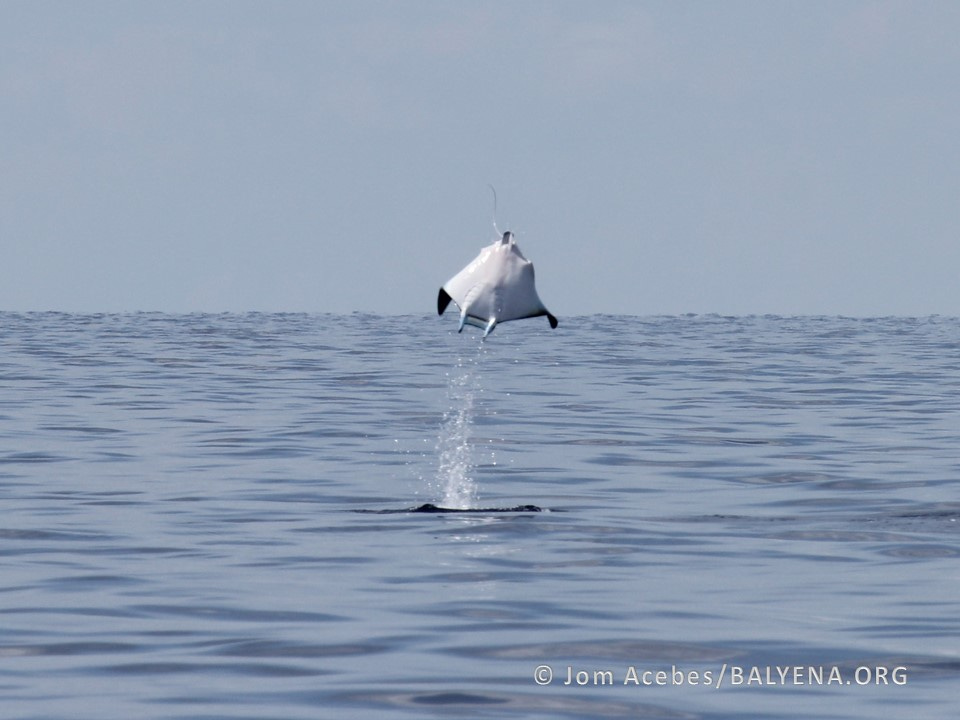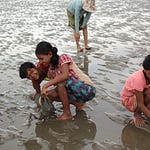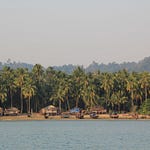KEY TOPICS:
Social impacts of conservation on communities (human collateral damage)
Conservation missteps that alienate communities & harm long-term impacts (as I call them, "counterproductive conservation pathways")
Manta & mobula ray protections: How it manifested in the Philippines
Fisheries & bycatch
Precautionary principle
How conservation reminds me of James Bond chase scenes
LINKS:
INTRO
Hello everyone, and welcome to Conservation Realist! I am, first of all, very sleepy today, but that does not take away from the excitement I feel about sharing this continuation of my conversation with Dr. Jo Marie Acebes, or Jom, that started in Episode 2. This conversation was divided into 2 episodes because, well, she was the first person I interviewed and I'd had this vision of episodes that were only 30-40 minutes long - I thought that would be nice and approachable. But everyone has had so many interesting things to say, and I am much more long-winded than I ever anticipated in these introductions, so they've been more like an hour long.

But this one really lent itself nicely to being divided into two episodes because we covered two pretty hefty topics, the first one being colonial science (and I learned a lot from that). The second one is a topic that I'm more directly familiar with, but I love. I don't love that it exists as a problem, but I love delving into it, and that is the human collateral damage in conservation.
I don't lay claim to that term - I'm sure someone else has written it up nicely somewhere - but it just popped into my head when I was sending Jom a list of topics that I thought we could talk about. The term "collateral damage" implies that the damage is an aside. It's not intended, but it also treats it as kind of negligible in a way. So both the intent but also how seriously the impact itself is taken.
I'll frame this, in a way: you know when you're watching an action movie, like a James Bond film, and there's a chase scene. Of course, you're looking at the villain and James Bond and the super cool vehicles they're in and the stunts. But you know what I see? The fruit stalls in the market that are overturned or people's houses that are damaged or cars that are banged into (and "oh my god, was everyone in that car okay?"). It's just this trail of destruction behind them, and me, in my head, thinking "but what about all those people?!"

But us viewers are supposed to be keeping our eye on the shiny motorcycles or sports cars or whatever else they throw into those chases and James Bond and the flashy villain.
That's kind of how I feel about what happens a lot of times in conservation, though of course it's a lot less dramatic, a lot less exciting. In the pursuit of what we generally agree are very good goals - saving species, biodiversity, natural resources - pursuing these goals often results in negative, generally unintended, impacts. But these are impacts that are not out of thin air. If you gave serious thought to the context in which these conservation interventions are taking place, you probably could anticipate a lot of these impacts, prepare for them, either prevent them or put in meaningful mitigation measures.
Unfortunately, I feel like the significance of these impacts is often minimized. So, we want to keep our eyes on the stars of the show, which is the species that's being saved and maybe the brave, selfless conservationists who are saving them, and these communities who are negatively impacted by the actions involved in trying to save those species are treated as sort of uninteresting, maybe inconvenient, bystanders almost.
And not only is this wrong from a human rights and dignity and equity point of view, it also really hurts conservation. It's an impractical way to approach conservation, because you're going to end up alienating communities who could and should be powerful partners, if not the leaders, in conservation. This is something that Dr. Ruth Brennan in the previous episode, Episode 7, spoke about powerfully.
When you alienate communities by inflicting harm on them, whether purposeful or not, you risk putting into place what I've phrased as "counterproductive conservation pathways." I haven't published it yet, it's been in a couple of my conference presentations. This was a phrase that came to mind when I was doing research on the vaquita, the most endangered marine mammal in the world in the Upper Gulf of California in Mexico.
Before I go further, I so appreciate any way in which you choose to engage with this podcast. I would absolutely love it if you could like, share, subscribe, write reviews, especially write comments on the Substack site and maybe get some discussions started. And if you have the means and feel so motivated, there is a "donate" button on the About page in Substack. That is the end of this promotional message.
Back to Doc Jom: as a reminder, she is the founder and principal investigator of BALYENA.ORG, a non-profit organization in the Philippines that works to support the conservation of whales, dolphins, and their natural habitats. They do great work. You can find more information about Jom in Episode 2.
This conversation is one of the many reasons I adore spending time with Jom when we overlap in time and space. This conversation is very real, a very accurate portrayal of a lot of the conversations we actually have in unrecorded real life.
I'm going to quickly provide some background information for those of you who might not be as familiar with small-scale fisheries or big marine animal (marine megafauna) landscape, especially in the Philippines.
Bycatch has come up on this podcast before - it's the non-targeted catch or the accidental capture of species in fishing gear. Bycatch can be anything that you're not meaning to catch. So it can be other species of fish. It can be dolphins, whales, marine turtles, sea lions, so marine megafauna - that includes elasmobranchs (sharks and rays). I have a lot more to say about bycatch in an upcoming episode and newsletter
The precautionary principle: This is a really important idea that Jom brings up, it's one of the central operating principles of conservation. Basically, there's a lot of uncertainty when we're looking at data in conservation. The species we're often trying to conserve are very inconveniently (and, I might add, inconsiderately) difficult to study. So we don't really have precise or accurate numbers for how many of them there are, and how many of them are being impacted by human activities. With small-scale fisheries, it's also hard to measure exactly what they're doing, because they're very dispersed. When marine megafauna, for example, and small-scale fisheries exist in area where there's limited resources for concerted research, there is a scarcity of data.
On the other hand, there's a real sense of crisis about losing biodiversity. It is a huge loss, a significant loss, to lose a species, even a population or subpopulation, is a loss that you can never get back. I think a lot of us in conservation have been trained to have this urgent mindset that "things have to happen, and they have to happen now." The precautionary principle is basically: okay, we might not have perfect information - let's act in a way that's conservative that's erring on the side of saving the species, even if some of the interventions might be... unnecessary, or might be stronger than needed. I totally understand the merits of precautionary principle - I'm not saying it's not important. The problem is that the "precaution" is generally only applied on the side of the species and conservationists, and it doesn't take into account that these interventions can harm living, breathing people with rights.
Precaution also needs to be exercised in that direction as well. There's a responsibility that needs to come with exercising the precautionary principle for conservation. A related idea going along in that direction would be environmental and social safeguards. Basically these are measures that organizations and projects in some cases need to put into place to show that they've thought about these possible negative impacts, and about ways to avoid them or mitigate them. That's something worth looking into if you're not familiar with that term already.
Jom refers to a community she's worked with in Bohol, which is a province and island in the Central Visayas in the Philippines, so the central part of the country
She talks about mobula rays, basically a family of rays - Mobulidae - and about gill rakers, which are cartilaginous structures on the inside of the gills that protect the gills but also in rays have evolved to strain plankton, similar to baleen in baleen whales. They're also coveted for medicinal purposes, so this would be analogous to the shark fin trade in that sense.
This is where CITES comes in. So CITES is the Convention on International Trade for Endangered Species of Wild Fauna and Flora, and it's an international agreement to ensure the survival of a species isn't threatened by trade in products derived from harvest or exploitation of that species. In 2017, all species of mobula rays were listed under CITES under Appendix II. It's important to know the differences between the appendices: Appendix I is for the most endangered species, so there's no trade allowed (there are some exceptions for non-commercial use, e.g. for research, but that requires the granting of a permit).
Appendix II is kind of a lower tier, so species listed under Appendix II are not necessarily threatened with impending extinction, but they might become threatened if trade in their products is not carefully monitored and managed. So how a listing of these mobula rays under Appendix II of CITES affected fisheries management in the Philippines is something that Jom talks about. A really important point is how this listing was interpreted, translated, and implemented in Philippine law. There's a question of what the burden of proof is and what the proper procedure should be.
Jom also briefly references a mutual friend and colleague of ours, Jean Utzurrum, who we admire and like very much even though she focuses more on fishy things and elasmobranch things rather than marine mammal things these days. Jean is another Filipina researcher. You might well be familiar with her from Twitter, and I actually have another episode featuring her coming up. We've got some great representation from the Philippines in this podcast.
Okay. Someday I'll master the art of a succinct introduction, but that's not today. For now, let's listen to a clip of the song "The Green Touch" from Soe Moe Twin, Zyan Htet, and Min Min from Myanmar, and dive into this spicy conversation with Jom!
[MUSIC]
TRANSCRIPT
T: I'd like to pivot now and talk about the second topic, which I know we've talked about... I don't know how many times... I think it's one of our favorite conversation topics when we get together. It's this idea of when conservation harms local communities - this kind of human collateral damage that I think conservationists have far too high a tolerance for. I'd really love to hear you at least briefly share the examples in which you've noticed this and give a little bit of background on that.
J: First, I really like that term, human collateral damage. Because like you said, it's not really always recognized, sadly. But I think it happens more often than a lot of people think, because partly scientists tend to think about only the species. And from my experience, I guess I could say that it was only when I started working on species that involved fisheries that I realized that, that they're so entwined that there's no way you can do any work on a species that's been traditionally hunted or caught without touching on the people.
So I guess the best example I know in the Philippines, but I'm sure there are so many others, is when a species that has been hunted for decades becomes illegalized. And the scientists maybe unknowingly - at the beginning - may have been thinking "Oh, it's illegal now, so you should stop hunting them."
But then the mistake I think that happened here is when you tend to just want to work on your species, even though you've already realized that people are being affected. That when you, protecting species, you're basically taking away the livelihoods of communities, and not recognizing that or even trying to do something about it when the damage has already been done.
From our experience, specifically for the manta and mobula rays - yes, manta rays have been protected for a very long time, but the mobula species was very recent - the people who were working on fisheries monitoring with the people [communities] weren't really part of this other group that was advocating for this protection internationally. And I think, to give them [protection advocates] the benefit of the doubt, they didn't also realize that it would suddenly just be affecting local policy, because most, like CITES - yes we are signatory to CITES, but the normal procedure is that they would have to translate that into a national law for it to be effective and with certain implementing rules and regulations, but that didn't happen.
So when they were able to advocate for the protection of all these species, it was automatically adopted into our fisheries code, and was misinterpreted to say that it's going to be illegal unless you can prove otherwise, when the law - our fisheries code - actually says the other way around: it shouldn't be illegalized until you can say that what they're taking is actually more than the capacity. So people, the fishers, were never included in any of these discussions. Yes, they were warned - by us - that it's happening out there, people are talking about this, that they're going to make it illegal, but no one from the government agency or the NGOs advocating for the protection went to talk to them. Not a single one. And they were never invited to any of the meetings. And [conservation advocates] refused to realize how important it was for their income. So the law was passed. [This fishing] was abruptly stopped.
And these people, even until now, lost a very huge chunk of their income from the fishery that was illegalized. And the things that were promised to them by the local government just never really happened. Like they were promised a new type of fishery, more provisions for drying fish, etc., and catching other species, converting their boats, etc. That never happened. And what I think the sad part, in terms of conservation, is: (1) it doesn't really guarantee that the species are protected, because there's still bycatch, and actually the bycatch is a lot bigger than the targeted fishery because mobulas are the type that get caught in all these gillnets, so you didn't really stop that and you just basically put it underground.
So, at least before, when it was still legal and researchers were able to monitor it, the fishers were very welcoming to researchers. Now, they will not only not report to you, but they will probably never trust a researcher again. That's the notion now: someone's coming here doing research, they're going to make it illegal soon enough. Because that's exactly what happened, and this is not the first time it's happened. It's happened before, with the whaling and the whale shark hunting - that's exactly what happened. Someone was doing the research, and in the end, without the fault of the researcher, the species were protected, so they had to stop hunting. It definitely leaves a bad taste in the mouths of fishers, and you lose the trust, so all the years of hard work, getting their trust, that's all gone. They'll never believe you anymore because of that.
So it's not really good for conservation in general. You lose the trust of the people. You lose their trust of people in science in general. And it doesn't really guarantee that the species is protected. No one's going to report to you. And everything's underground.
T: Unfortunately, as you mentioned, I can think of other examples of this, and you know I studied one in relation to the vaquita in Mexico. But I've seen other examples, smatterings of other examples, from my other experiences in different countries. And I think it's common for conservation researchers and conservation organizations to treat it like it's a simple situation in a lab setting, instead of being in an intertwined web of the real world. There's no simple "I'm saving the planet doing something good." There's no simple checkbox. You're operating in a realm where your actions can have very real, very significant impacts on real people.
J: Absolutely. That's the thing about those conservationists who are advocating for it. At first, you can say, okay, they didn't know. Because of course they didn't know, they're in Manila! They've never met these people, they've never been on their beach. So they just have no idea that their actions are affecting all these people. For them, they're comfortable there because it doesn't affect them at all. They do get a lot of recognition, without them knowing that people are losing livelihoods and income with what they're doing.
T: It kind of reminds me of what you said about parachute science in that there's this disregard for a certain type of person's voice. A total disregard for their rights and their dignity, and it doesn't have to be malicious, it could be ignorance, but it still does harm all the same.
So in this situation with the mobulas, how - once it became more clear that that the communities were facing substantial impacts - how did the conservationists pushing for this strict protection respond?
J: Nothing! [laughs] Well, no, I can't say nothing. They did try, once, to reach out. I just can't verify it because I didn't see it. But they said they went to the village, or the municipality, and had a meeting with them. But I wasn't there when they had that meeting. And when I was asking the people what did you talk about, they obviously didn't understand what they were there for, and they said actually not a lot of the fishers who were directly affected were actually at the meeting. And then I only saw an attendance sheet (you know how we love attendance sheets), and the people listed there were not actually people who were fishing for mobulas. It's like... just show that we went and tried to reach out, but they didn't really do the effort - it was just to say that they did something. And that was it.
T: It was just checking the box.
J: Yeah, literally, "yeah, we did that... once." And there was also a shark summit where they invited one person to go there, and luckily that one person was a more outspoken once - he was actually a councilor at the time. But still, just seeing their reaction to what he was saying, it just went in one ear and out the other. They can say, "Oh, this guy came and we let him speak," but they didn't really do anything about it.
T: That's another... "pet peeve" is an understatement... is people's very limited understanding of what inclusion and participation actually are. It doesn't mean that you let someone speak at your meeting. It means that you actually paid attention to what they said and integrated it. I like to try to extend the benefit of the doubt, to all parties, but I don't understand listening to someone telling you - in the same room - that something has so radically affected their life, and not respecting that nor doing better because of it.
J: It's going to sound bad, but they don't even listen to me. When I speak at the conference with the people who advocated for it, it's like: they're looking at you, but they're not really listening. They will not acknowledge that what you said is right. And I feel that, if they don't believe me, how much would they believe [community members]? It's like that. To me, it's insane. And I'm not saying all of them - for example, Jean [Utzurrum] is there, and only Jean is listening to me! - but everyone else is like, okay, okay okay, and that's it, I'm just the annoying bitch lady talking about fishers talking in Bohol. That's just about it!
T: I mean, it's really unfortunate, and it really, like you said, harms conservation long-term. Because the communities are the ones who are there all the time, on the ground. If you don't engage them, you really have nothing long-term, especially if it's in a situation where you don't have the infrastructure for these super long-term sustained projects.
J: Like I said, it doesn't really help the species anyway. It's nice on paper. But if you really look and find out, okay, did it stop the dying of mobulas?
T: I think it also speaks to a very narrow view of the overall conservation of the species, and the social-ecological context in which its conservation has to take place. If you just focus on one side - we're taking a step that we believe will reduce an impact - without really understanding where all the other impacts are coming from... Bycatch is really hard to deal with. I understand why it's easier to just stop people from fishing for it, from targeting it. Like you said, it looks good on paper. You can maybe prove, more, that you've done that much. Whereas bycatch is probably the most frustrating problem I've come across. But, like you said, it's not really rooted in any real, genuine effort that's going to do any good for the species.
J: And if someone's going to audit you, and talk to the people, they're not going to say anything good about you!
T: Exactly. This is what I found in the case of the vaquita. That's where I described it as "counterproductive conservation pathways." It's not only not doing anything productive, but it's actually hindering future productive work in conservation. So how do you think this situation could have been handled better? Obviously, including fishing communities from the beginning... any other key steps in there?
J: This is something that I actually talked about with the fishers, and they were open about the idea. It's regulating it, not completely illegalizing it. But instead, by looking at the data - we did have some data on the fisheries, with the help of the locals obviously - we could tell when is the peak of the season when they'd see a lot of pregnant animals. Then they could just say, okay, from the month of November to December, you have to pause - you cannot hunt or fish for mobulas during that time, because of this. And they understand that.
And/or you could limit the number of boats. There were only 15. Like I said, that's also the mistake that a lot of the advocates and conservationists were citing: they kept using the example of Sri Lanka, wherein fishers for mobulas and mantas were going out for days and stocking up because they have bigger boats that would go out on long fishing trips. That's not the case in Bohol. They would go out every day and come back, because they don't have big boats. The idea there is they prefer it fresh. And also, yes, the gill rakers were more expensive than the meat, but the locals were really more after the meat. The gill rakers are a recent plus. The meat was sold locally, so they wanted that and they wanted it fresh. So that was a main factor.
So with that alone, they're already limiting how much they could catch per day. So by limiting the number of boats - no new boats can enter the industry - we stick to the 15. If one of the boats gets destroyed for some reason, then maybe you can consider adding a new one. But normally you stick to 15. So you can do that together: limiting the season when they can catch and then limiting the number of boats who can get involved in the industry.
They [community members] were very open to that idea, instead of completely telling them "stop right now." So I think if that was considered, that would have worked so much better for both parties, because yes, you're still catching some of them, but at least you're slowly try to limit - at least we're protecting the pregnant ones, during the breeding season, and then you can't get any bigger in terms of the industry (so limited to only 15). And at the same time, they will still allow you to get data from them. Then you can really study: okay, are they really catching more than they should? Because even that, scientists couldn't answer, because we didn't have enough information to actually say that.
Yes, I know, people are saying, "oh, the precautionary principle!" But these are lives of people we're talking about, and it's not that easy just to say to them, "Oh, we're just trying to be safe here." You're being safe for the species, but what about them? So they should at least have been given more time to consider alternatives, if that's even possible. But honestly, for a community of fisherfolks, fishing is their life. And it's very important for them, not just for money. It's just the way they live.
T: Yes, exactly! And I think conservation really loses out on potentially very powerful allies when they alienate communities like that.
Well, thanks, Jom. Every time you talk about this example, I feel like I gain more insights. I think it's the kind of conversation that more conservationists need to be having among themselves, very honestly and in a way in which they're willing to admit mistakes and forward-looking to how they can improve what they're doing.
OUTRO
Alright, folks. That's it for this conversation with Jom. I decided not to once again splice our "Thank you"s and "good bye"s which I already used in Episode 2. I thought it'd be a little weird to use them again, although I'm sure that no one would even be keeping track. On a related note, I want to get you intrigued and excited for a future episode which will be toward the end of this season, in late July, where I will be taking answers that every one of the folks I've interviewed have given me to three kind of rapid fire questions I give at the end of each conversation. These are questions and answers that I think are though-provoking and were a nice way to end each conversation, and I thought it would be interesting to present them all in one episode. I realize now that it's going to be a lot of editing, but it will be worth it!
So thank you again, maraming salamat, to Doc Jom, and thank you to all of you listening! Take care.













Share this post